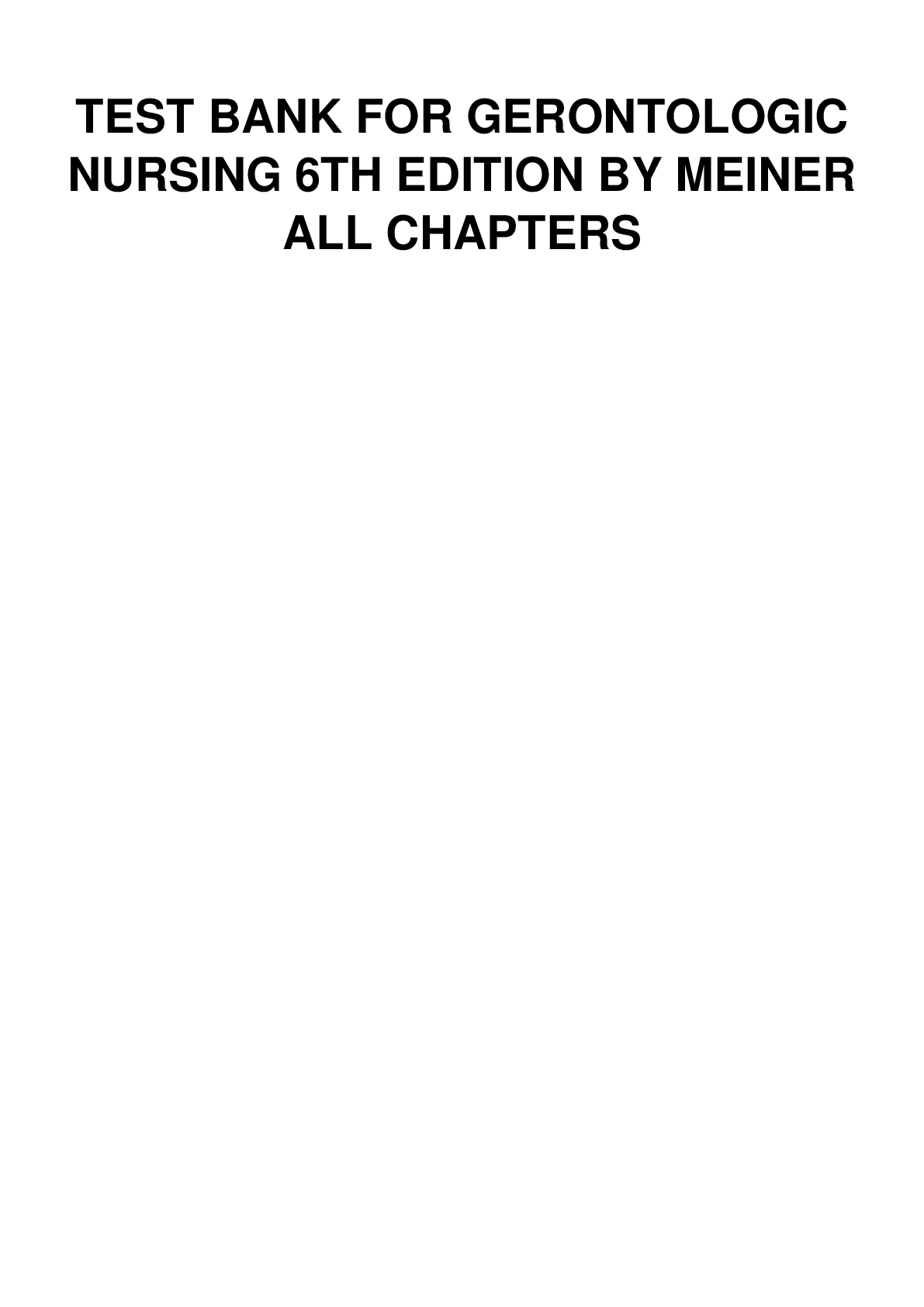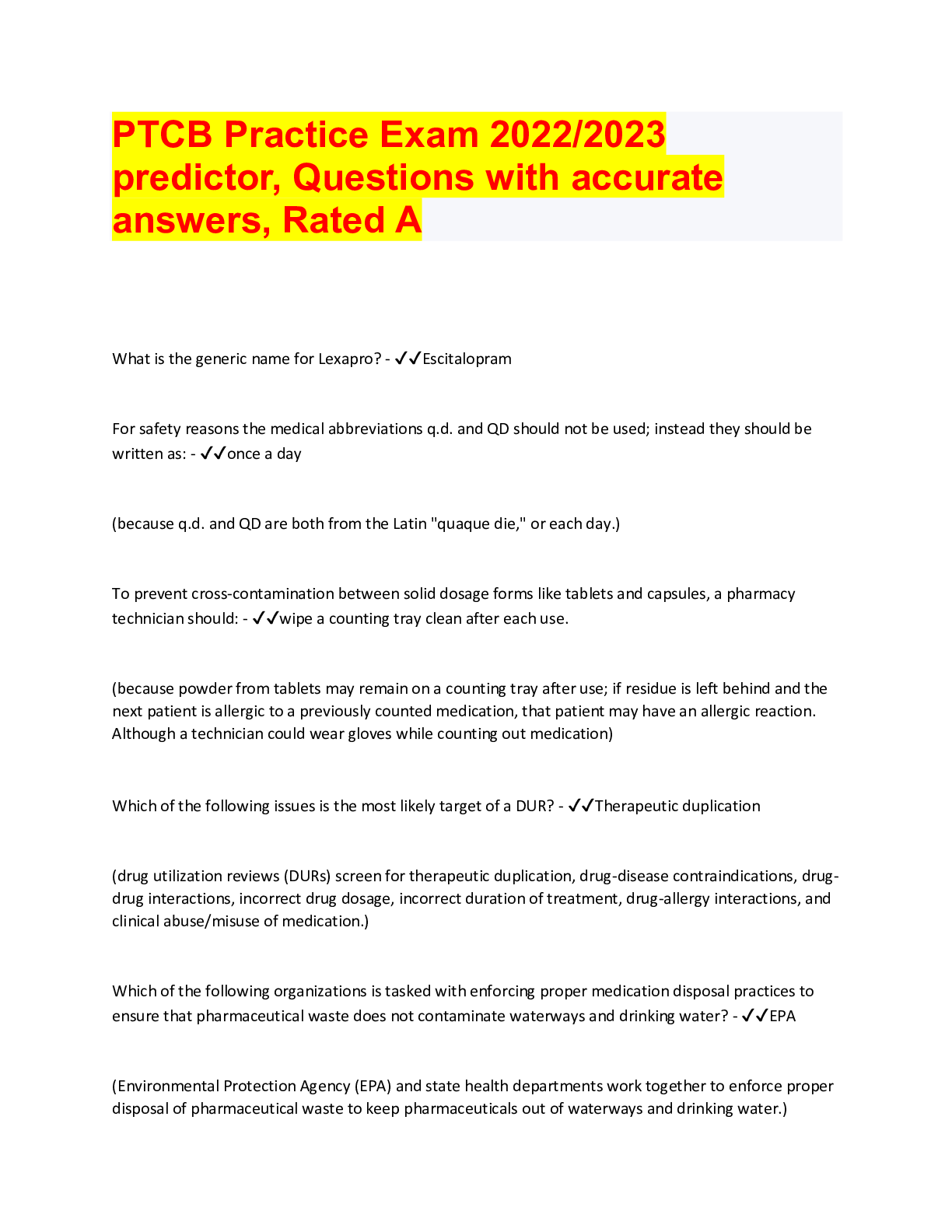*NURSING > QUESTIONS & ANSWERS > Adult Health Nursing 6th Edition By Kockrow (QUESTIONS AND ANSWERS) GRADED A (All)
Adult Health Nursing 6th Edition By Kockrow (QUESTIONS AND ANSWERS) GRADED A
Document Content and Description Below
Adult Health Nursing 6th Edition By Kockrow MULTIPLE CHOICE 1. A patient has generalized macular-papular skin eruptions and complains of severe pruritus from contact dermatitis. When the nurse... administers his therapeutic bath, it is important to remember that a. using Burow’s solution helps promote healing. b. rubbing the skin briskly decreases pruritus. c. allowing 20 to 60 minutes to complete the bath will prevent pruritus. d. sterilizing all equipment used will prevent pruritus. 2. A patient, age 63, has cancer of the left breast. After a modified radical mastectomy, she has been receiving chemotherapy. Her grandson, who visited a few days ago, now has varicella (chickenpox). The nurse should observe her carefully for signs of a. herpes zoster. b. herpes simplex type I. c. herpes simplex type II. d. impetigo. DIF: Cognitive Level: Analysis REF: Pages 72, 74 OBJ: 9 TOP: Chemotherapy KEY: Nursing Process Step: Assessment MSC: NCLEX: Physiological Integrity 3. A patient has herpes zoster (shingles). A local antiviral agent, which is useful in delaying the progression of herpetic diseases, was prescribed. This medication is a. lorazepam (Ativan). b. hydroxyzine (Atarax). c. acyclovir (Zovirax). d. hydrocortisone (Solu-Cortef). 4. A child has been sent home from school with pruritus and honey-colored crusts on his lower lip and chin. A probable diagnosis would be a. chickenpox. b. impetigo. c. shingles. d. herpes simplex type I. 5. A patient has an erythematous patch of vesicles on her scalp, and she complains of pain and pruritus. A diagnosis of tinea capitis is made. The causative organism is a. bacterium. b. virus. c. worm. d. fungus. 6. A patient, age 46, reports to his physician’s office with urticaria and papules on his hands and arms. He says, “It itches so badly.” In assessing the patient, the nurse should gather data regarding recent a. travel to foreign countries. b. upper respiratory tract infection. c. changes in medication. d. contact with people who have an infectious disease. DIF: Cognitive Level: Analysis REF: Page 81 OBJ: 8 TOP: Urticaria KEY: Nursing Process Step: Assessment MSC: NCLEX: Physiological Integrity 7. A patient has been receiving penicillin, acetaminophen with codeine, and hydrochlorothiazide for 4 days. He now has a urinary tract infection. A sulfonamide has been prescribed to be taken three times per day. Several hours after the second dose , he complains of pruritus. The nurse observes a generalized erythema and rash. The most appropriate nursing intervention would be to hold a. all medications, and notify the physician of the signs and symptoms. b. the penicillin. c. the acetaminophen with codeine. d. the sulfonamide. 8. A patient has acne vulgaris. When the nurse explains this condition, it is most important to a. stress the importance of strict hygiene. b. discuss the connection of diet and stress. c. explore how this condition is affecting his self-image and lifestyle. d. describe in detail the proper use of prescribed medication. 9. A 30-year-old African American had surgery 6 months ago. Her incisional site is now raised, indurated, and shiny. This tissue growth is most likely a(n) a. angioma. b. keloid. c. melanoma. d. nevus. 10. A patient, age 37, sustained partial- and full-thickness burns to 26% of her body surface area. The greatest fluid loss resulting from her burns will usually occur a. within 12 hours after burn trauma. b. 24 to 36 hours after burn trauma. c. 24 to 48 hours after burn trauma. d. 48 to 72 hours after burn trauma. 11. Most of the deaths from burn trauma in the emergent phase that require a referral to a burn center result from a. infection. b. dysrhythmias with cardiac arrest. c. hypovolemic shock and renal failure. d. adrenal failure. 12. A patient, age 26, is admitted to the burn unit with partial- and full-thickness burns to 20% of his body surface area as well as smoke-inhalation injury. Carbon monoxide intoxication secondary to smoke inhalation is often fatal because carbon monoxide a. binds with hemoglobin in place of oxygen. b. interferes with oxygen intake. c. is a respiratory depressant. d. is a toxic agent. 13. A nurse arrives at an accident scene where the victim has just received an electrical burn. The nurse’s primary concern is a. the extent and depth of the burn. b. the sites of entry and exit. c. the likelihood of cardiac arrest. d. control of bleeding. 14. A patient, age 27, sustained thermal burns to 18% of her body surface area. After the first 72 hours, the nurse will have to observe for the most common cause of burn-related deaths, which is a. shock. b. respiratory arrest. c. hemorrhage. d. infection. 15. A duodenal ulcer may occur 8 to 14 days after severe burns. Usually, the first symptom is bright red emesis. Which condition matches this description? a. Curling’s ulcer b. Paralytic ileus c. Hypoglycemia d. ICU psychosis syndrome 16. A nurse is providing the open method of treatment for a patient who is 52 years old with burns to her lower extremities. It would be important for the nurse to a. change the dressing using good medical asepsis. b. provide an analgesic immediately after the dressing change. c. perform circulation checks every 2 to 4 hours. d. keep the room temperature at 85° F (24.4° C) to prevent chilling. 17. The nurse has initiated measures to promote suppuration of a carbuncle. Which assessment would indicate that these measures have been successful? a. The area is erythematous and scaly. b. The area has begun to drain exudate. c. The area is not erythematous or edematous. d. The area has stopped draining exudate. 18. A patient, age 20, is admitted with severe eczema. In planning the care for her, the nurse should plan to a. keep the skin well hydrated. b. change the dressings every day. c. keep the skin clean and dry. d. administer antibiotics for the infection. 19. The nurse is caring for a 26-year-old patient who was burned 72 hours ago. He has partial-thickness burns to 24% of his body surface area. He begins to excrete large amounts of urine. The nurse should a. slow the IV solution and monitor for burn shock. b. monitor for signs of infection. c. assess for signs of fluid overload. d. raise the foot of the bed and apply blankets. 20. A patient, age 29, is diagnosed with genital herpes. She is receiving acyclovir (Zovirax). Which would indicate a therapeutic response? a. Decrease in pruritus b. Decrease in pain c. Increase in WBC count d. Increase in activity tolerance 21. A female patient is seen by the school nurse because of flat lesions that are clear in the center with erythematous borders. In assessing a patient for tinea corporis, the nurse would check a. soles of the feet. b. back of the scalp. c. groin area. d. anterior abdomen. 22. A patient has been walking in the woods. He complains of severe pruritus. The nurse notes an erythematous area on his lower legs. The first nursing intervention for dermatitis venenata would be to a. administer Benadryl, 50 mg IM. b. wash area with copious amounts of water. c. apply cool compresses continuously. d. expose area to heat and air. 23. The nurse debriding a wound explains the purpose of debridement is to: a. increase the effectiveness of the skin graft. b. prevent infection and promote healing. c. promote suppuration of the wound. d. promote movement in the affected area. 24. A patient has been admitted to the hospital with burns to his upper chest. The nurse notes singed nasal hairs. It would be important for the nurse to assess this patient frequently for a. decreased activity. b. bradycardia. c. respiratory complications. d. hypertension. 25. Which may indicate a malignant melanoma in a nevus on a patient’s arm? a. Even coloring of the mole b. Decrease in size of the mole c. Irregular border of the mole d. Symmetry of the mole 26. A dark-skinned patient has been admitted to the hospital in severe respiratory distress. To determine whether the patient is cyanotic, the nurse uses what knowledge of skin assessment? a. It is not possible to assess color changes in patients with dark skin. b. Cyanosis in patients with dark skin can be seen only in the sclera. c. Cyanosis can be seen in the lips and mucous membranes of patients with dark skin. d. Cyanosis will blanch out with direct pressure to the soles of the feet in dark-skinned patients. 27. A patient developed a severe contact dermatitis of her hands, arms, and lower legs after spending an afternoon picking strawberries. She states that the itching is severe and she cannot keep from scratching. Which instruction by the nurse will be most helpful in managing the pruritus? a. Use cool, wet dressings and baths to promote vasoconstriction. b. Trim the fingernails short to prevent skin damage from scratching. c. Expose the areas to the sun to promote drying and healing of the lesions. d. Wear cotton gloves and cover all other affected areas with clothing to prevent environmental irritation. 28. A patient is a 32-year-old woman whose mother recently died from malignant melanoma. She asks the nurse about what she can do to prevent the development of malignant melanoma in herself and her children. The best response by the nurse includes which information regarding risk factors for melanoma? a. Avoid exposure to the sun and use protective measures when exposure occurs. b. Have all nevi removed. c. Watch for changes in moles, especially on the back. d. There is nothing that prevents malignant melanoma, but it is curable if detected early. 29. In addition to medication management of systemic lupus erythematosus, which supportive therapy would help control the disease? a. Balanced diet and balance between rest and activity b. Increase in activity to promote mobility c. Exposure to the sun to increase vitamin D absorption d. Increased sodium consumption 30. Cellulitis is a potentially serious infection. In adults Staphylococcus aureus can cause which complications? a. Sepsis and meningitis b. Appendicitis and vasculitis c. Tinea pedis and tinea corporis d. Urticaria and psoriasis 31. Nursing interventions for treatment of herpes virus infections are: a. Keep the lesions moist to prevent pain. b. Apply cold, moist compresses to lesions. c. Focus on treating symptoms and preventing spread of virus. d. Cleanse lesions with alcohol. 32. Parasitic skin diseases are identified as pediculosis or scabies. The difference between pediculosis and scabies is a. pediculosis only occurs in poor living conditions. b. scabies only occurs when there is poor hygiene. c. scabies is caused by mites that burrow into the skin. d. lice is caused by mites that attach themselves to bare areas of the skin. 33. Melanocytes give rise to the pigment melanin which is responsible for skin color. The melanocytes can be found in a. Dermis b. Superficial fascia c. Epidermis d. Loose connective tissue COMPLETION 34. The three major glands of the skin are __________, ___________, and __________. 35. The most deadly skin cancer is ________________. 36. Place the steps in order for the medical treatment during the emergent phase of burn management from the list below. Place a comma between each answer choice (a, b, c, d, etc.). a. Transport victim to hospital. b. Cover victim with clean cloth or sheet. c. Stop, drop, and roll. d. Remove all now-adherent clothing and jewelry. e. Provide an open airway. f. Control any bleeding. MULTIPLE RESPONSE 37. Major functions of the skin include: (Select all that apply.) a. excretion of wastes. b. protection. c. vitamin D synthesis. d. temperature regulation. e. prevention of dehydration. 38. During primary survey assessment of a burn patient, the nurse checks for early signs of carbon monoxide poisoning, which include: (Select all that apply.) a. dizziness. b. urticaria. c. vomiting. d. headache. e. vertigo. f. unsteady gait. 39. A common diagnostic criterion for identifying systemic lupus erythematosus (SLE) is: (Select all that apply.) a. butterfly rash over nose and cheeks b. photosensitivity. c. severe abdominal pain. d. skin ulcers. e. polyarthralgias and polyarthritis. f. immobility. 40. Nursing interventions and patient teaching for the treatment of head lice and scabies include: (Select all that apply.) a. clothing, linens, and bath articles thoroughly cleaned in hot water. b. stress nature and transmission of the disease. c. special carbohydrate diet to promote healing. d. complete isolation from the public. MATCHING Match the pathophysiological stage of burns with the greatest concern. a. Freedom from wound infection b. Hypovolemia c. Circulatory overload 41. Stage 1 42. Stage 2 43. Stage 3 Christensen: Adult Health Nursing, 6th Edition Chapter 05: Care of the Patient with a Gastrointestinal Disorder MULTIPLE CHOICE 1. The end-products of carbohydrate and protein digestion are absorbed by the a. bloodstream. b. blood vessels in the villi. c. lymphatic system. d. lymph vessels in the villi. 2. A 56-year-old patient with diverticulitis has been admitted to the medical unit. The nurse will most likely document which assessment in the charting? a. Chest pain b. Pain in the upper right quadrant c. Pain in the left lower quadrant d. Progressive weight loss 3. An ileostomy was performed on a patient for the treatment of debilitating ulcerative colitis disease. A problem the nurse should watch for in patients after this surgery is a. fluid imbalance. b. sexual activity restriction. c. skin excoriation. d. the collecting appliance being bulky and large. 4. A patient with cancer of the esophagus has been receiving radiation therapy. The nurse realizes that this patient should be assessed for a. aspiration from fistula formation. b. hemorrhage. c. incompetence of the suture line. d. dumping syndrome. 5. A patient has been admitted for diagnostic procedures including an esophagogastroduodenoscopy. The nurse explains to this patient that during this procedure, the physician will a. use a long, rigid, fiberoptic scope. b. order NPO status 1 hour before the procedure. c. view the esophagus, stomach, and upper small intestine. d. visualize the intestine but cannot remove polyps. 6. The nurse determines that a patient has a knowledge deficit regarding her diagnosis of achalasia. The nurse begins patient teaching by explaining that achalasia is a. a white patch on the mouth or tongue mucosa. b. caused by frequent ulceration on the lip. c. caused by excess exposure to sun and wind. d. caused by the inability of a muscle to relax. 7. Following a gastrectomy, the nurse would anticipate that the patient would need to be assessed for a. renal failure. b. vitamin B12 deficiency. c. obesity complications. d. continuing his routine diet. 8. A 63-year-old patient is admitted with acute diverticulitis. The most appropriate nursing intervention to lessen this patient’s signs and symptoms of increased flatus and chronic constipation alternating with diarrhea, anorexia, and nausea would be to a. encourage a diet high in fiber content. b. reduce oral intake to rest the bowel. c. encourage fluids to prevent dehydration. d. administer laxatives to prevent secondary constipation. 9. The patient, age 32, has ulcerative colitis, and his condition is deteriorating. An ileostomy is scheduled. After the procedure, this patient may be at risk for a. Activity intolerance. b. Sexual dysfunction. c. Disturbed body image. d. Ineffective thermoregulation. 10. Dumping syndrome after a Billroth II procedure occurs when high-carbohydrate foods are ingested over a period of less than 20 minutes. A nursing measure that will prevent or minimize dumping syndrome is to administer the feeding a. by bolus to prevent continuous intestinal distention. b. with large amounts of fluids to maintain hydration. c. high in carbohydrates and protein. d. in six small daily meals high in protein and fat. 11. The emergency room staff is caring for a patient with an acute inflammatory intestinal disorder who is being observed to rule out appendicitis. Which intervention is contraindicated? a. Give nothing by mouth until seen by a health care provider b. Measure intake and output c. Apply heat to the abdomen d. Encourage bed rest 12. After barium swallow contrast studies are performed, the nurse should ensure that the patient a. drinks adequate amounts of water. b. remains in bed for 6 hours. c. eats nothing until the gag reflex returns. d. expels all barium rectally. 13. A patient, age 36, is admitted with diarrhea and dehydration. The physician has ordered several diagnostic studies of the patient’s stools. When obtaining a stool specimen to be examined for ova and parasites, the nurse should a. use an oil retention enema to facilitate collection. b. refrigerate the specimen immediately. c. instruct the patient to obtain three different stool specimens on subsequent days. d. check the specimen for the presence of occult blood. 14. The patient, age 32, is admitted with possible appendicitis after being evaluated by the physician. It is appropriate for the nurse to administer a. fluid and electrolyte replacement. b. heat to decrease discomfort. c. a cleansing enema. d. an oral laxative. 15. A patient, age 84, has a history of a large left inguinal hernia. He is complaining of nausea, vomiting, abdominal distention, and inguinal pain. A serious complication of a hernia in which the blood supply to the tissue becomes occluded is called a(n) a. strangulated hernia. b. hiatal hernia. c. incarcerated hernia. d. sliding hernia. 16. A patient had a ruptured diverticulum in his descending colon. He has undergone a transverse loop colostomy. He asks the nurse the purpose of this procedure, and the nurse tells him that it is a. a temporary colostomy to allow healing of the bowel by diverting feces. b. to allow for more thorough irrigations. c. to provide two stomas for fecal elimination. d. to prevent chronic constipation. 17. The patient complains that he will never adjust to his colostomy. In this situation, it would be best for the nurse to a. encourage him to express his concern. b. suggest that he discuss his concerns with his physician. c. counsel him that everything will be all right. d. explain that his concerns will be dealt with when he is taught how to care for his colostomy. 18. The most important nursing intervention to assure the patency of a nasogastric tube (NG) is to: a. Clamp nasogastric tube 30 minutes twice a day. b. Monitor NG for patency and irrigate with sterile normal saline PRN as ordered. c. Cleanse nares at least once each shift; lubricate with a petrolatum ointment. d. Administer mouth care every 24 hours. 19. A progressive wavelike movement that occurs involuntarily in hollow tubes of the body, especially in the alimentary canal, to propel fluids, gas, and digestive substances forward is called a. perisclerium. b. periprostatic. c. pleurolysis. d. peristalsis. 20. A NANDA-accepted nursing diagnosis that could be written for a patient with an abdominoperineal resection and a permanent colostomy would include a. Disturbed body image. b. Ineffective thermoregulation. c. Ineffective protection. d. Autonomic dysreflexia. 21. Bowel sound assessment is especially important for a postoperative patient who has had abdominal surgery as it can determine the: a. need for a cathartic. b. return of peristalsis. c. presence of singultus. d. presence of eructation. 22. A NANDA-accepted nursing diagnosis that could be written for the patient who is hemorrhaging and in hypovolemic shock from a bleeding peptic ulcer would include a. Ineffective tissue perfusion (gastrointestinal). b. Unilateral neglect. c. Constipation. d. Disuse syndrome (gastrointestinal). 23. The goals of diet management in a patient with inflammatory bowel disease are: (Select all that apply.) 24. Restrict fluids to decrease peristalsis. 25. Prevent weight loss. 26. Correct and prevent malnutrition. 27. Provide adequate nutrition. 28. Replace fluid and electrolyte losses. 29. Limit high-caloric foods. a. a,b,c b. b,c,d,e c. a,c,f d. b,c,d,f 24. What nursing interventions would be appropriate for inflammatory bowel disease diagnoses of Imbalanced Nutrition: less than body requirements related to bowel hypermotility and decreased absorption? a. Provide three specific balanced meals a day. b. Restrict fluid to 1000 mL per day. c. Provide at least six small frequent meals per day. d. Allow alcohol and caffeine products. 25. Which nursing intervention would be the highest priority in evaluating a patient with peritonitis from a ruptured appendix? a. Assessment of severity, location, and duration of pain b. Assessment of vital signs c. Preventing wound infection d. Promoting balanced nutrition 26. Sulfasalazine is the recommended medication for treatment of Crohn’s disease. Patient teaching should include: a. taking medication 2 hours before meals. b. limiting fluid intake. c. ensuring adequate hydration to prevent crystallization in kidneys. d. increased effectiveness of oral contraceptives. 27. The most lethal complication of a peptic ulcer is a. bleeding. b. perforation. c. severe pain. d. gastric outlet obstruction. 28. Symptoms of GERD (gastroesophageal reflux disease) can be modified or eliminated by which nursing interventions? a. Eat three large meals daily. b. Follow a high-protein, high-fat diet. c. Remain upright for 1 to 2 hours post meals. d. Eat a snack 1 hour before bedtime. 29. The purpose of antibiotic therapy in treating stomach disorders is that it a. eradicates H. pylori. b. inhibits gastric acid secretion. c. protects the gastric mucosa. d. neutralizes or reduces the acidity of stomach contents. 30. Peptic ulcers are often common in the aging population. Which medications should be taken with caution to help prevent this problem? a. Antibiotics b. Antacids c. NSAIDs d. Laxatives 31. You administered the medication GoLYTELY to a 78-year-old woman in preparation for diagnostic tests. In planning for her care, which would be most appropriate? a. Side rails up to prevent falling b. Door closed for privacy c. Available bedside commode for possible weakness d. Monitor vital signs MULTIPLE RESPONSE 32. A patient is admitted with a diagnosis of Crohn’s disease. What nursing interventions would be appropriate when caring for this patient? (Select all that apply.) a. Daily weight b. Monitor I & O every shift c. Fluid restriction d. Accessibility to bedside commode 33. A patient was recently diagnosed with colorectal cancer. His wife asks the nurse, “What prevents colon cancer?” The nurse’s answer should include which factors? (Select all that apply.) a. A diet high in fiber b. Familial predisposition of a cancer-causing gene c. Regular checkups d. A diet high in animal fats 34. Constipation is a problem for many older adults. The medical management to prevent constipation includes (Select all that apply): a. Decreasing physical activity b. Decreasing fluid intake c. Nutritional diet high in fiber d. Increasing fluid intake e. Increasing daily activity f. Decreasing strict daily routines MATCHING Match the purpose of nasogastric tubes with its description. a. Internal application of pressure by means of inflated balloon to prevent GI bleeding b. Irrigation of stomach to remove secretions c. Relieve abdominal distention d. Instillation of liquid nutritional supplements into stomach 35. Decompression 36. Gavage 37. Compression 38. Lavage COMPLETION 39. Flexible sigmoidoscopy should be performed every ________ years. 40. Colonoscopy should be performed every ________ years. [Show More]
Last updated: 2 years ago
Preview 1 out of 33 pages
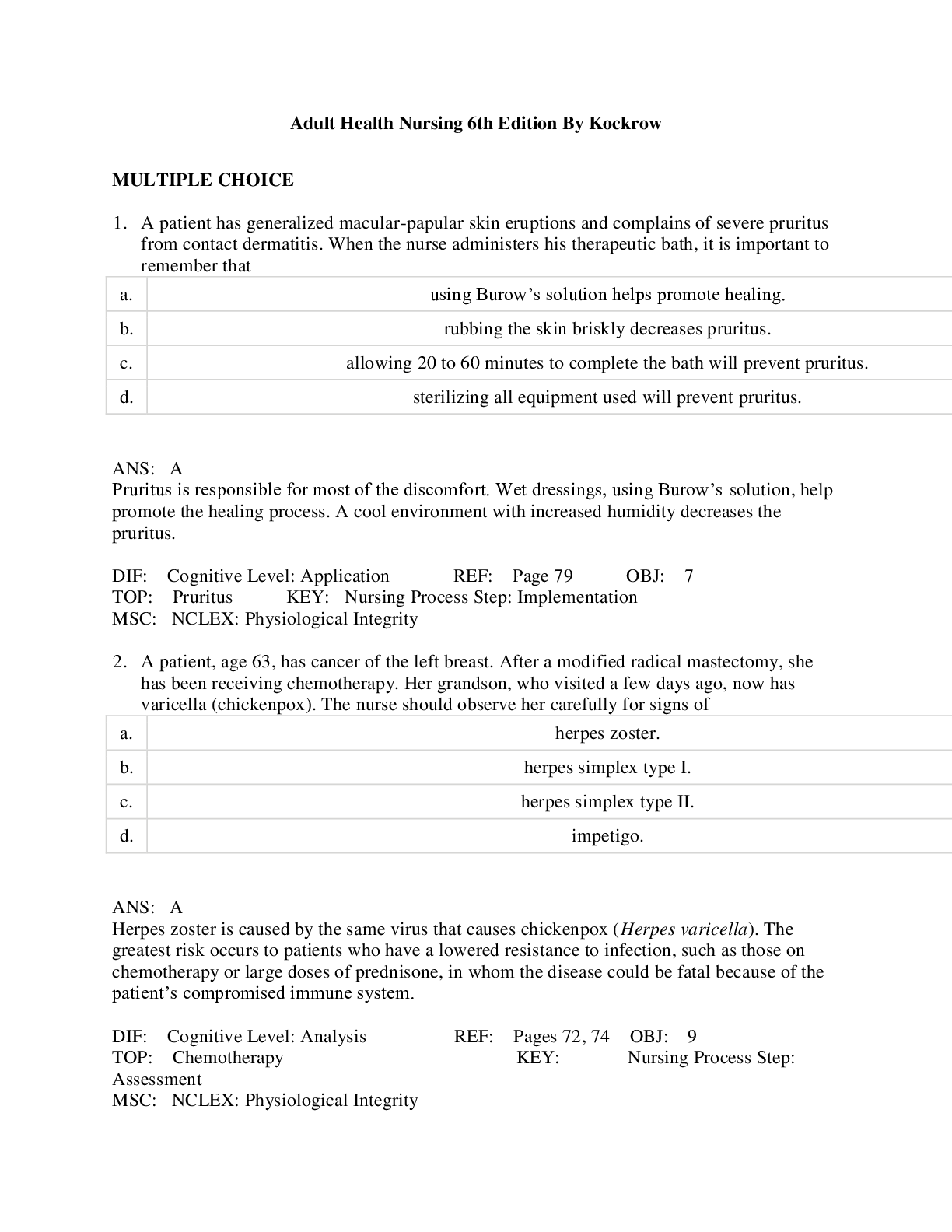
Buy this document to get the full access instantly
Instant Download Access after purchase
Buy NowInstant download
We Accept:

Reviews( 0 )
$12.00
Can't find what you want? Try our AI powered Search
Document information
Connected school, study & course
About the document
Uploaded On
Apr 11, 2020
Number of pages
33
Written in
Additional information
This document has been written for:
Uploaded
Apr 11, 2020
Downloads
0
Views
87

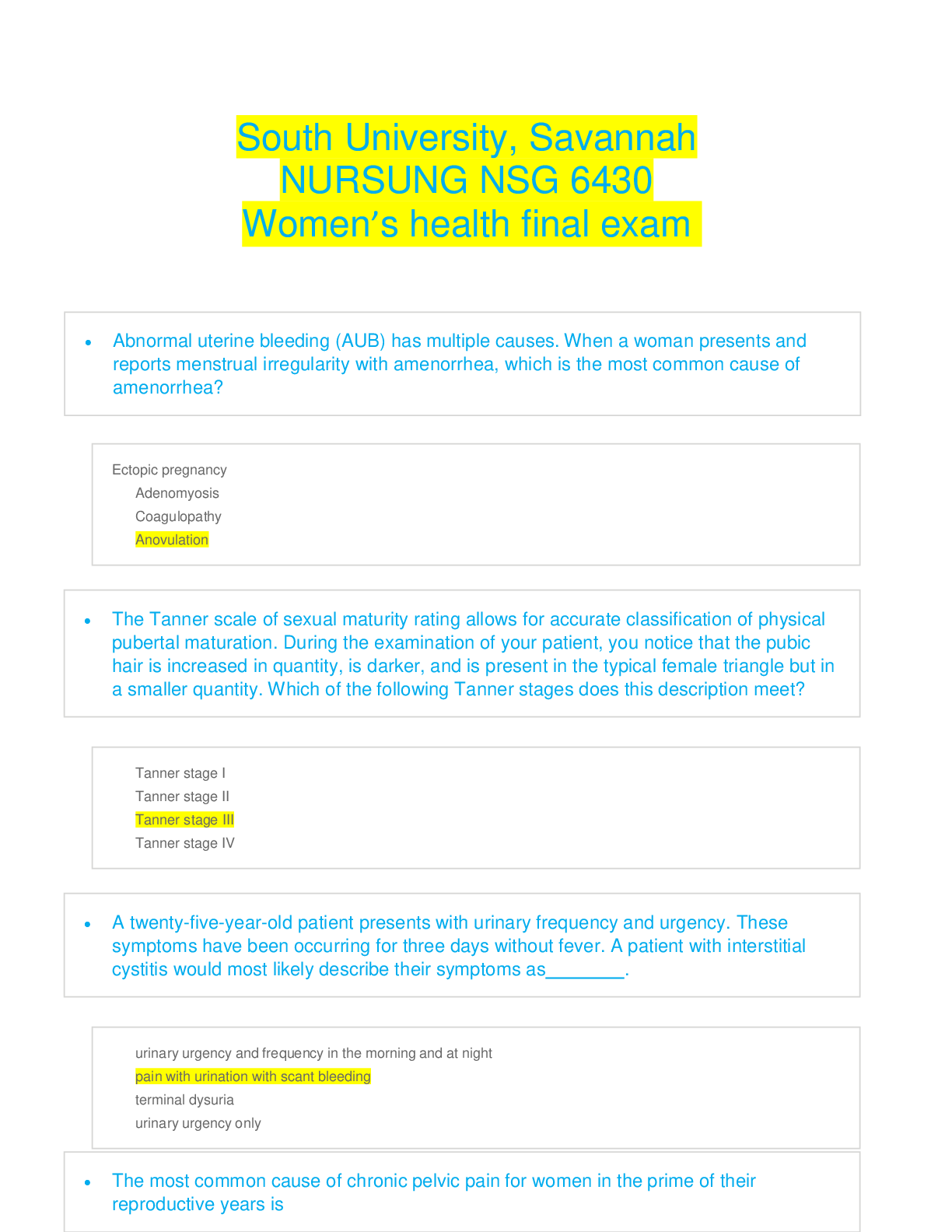

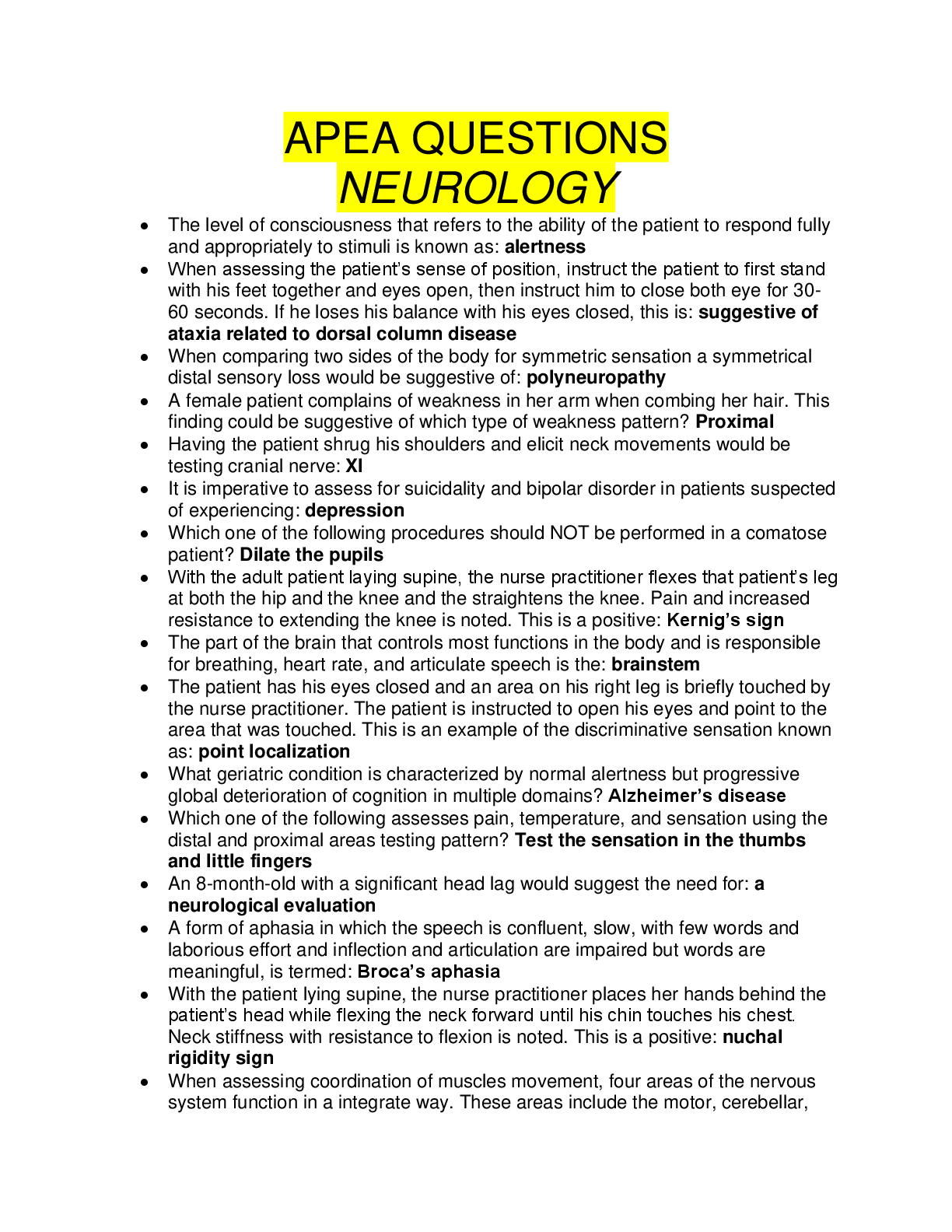

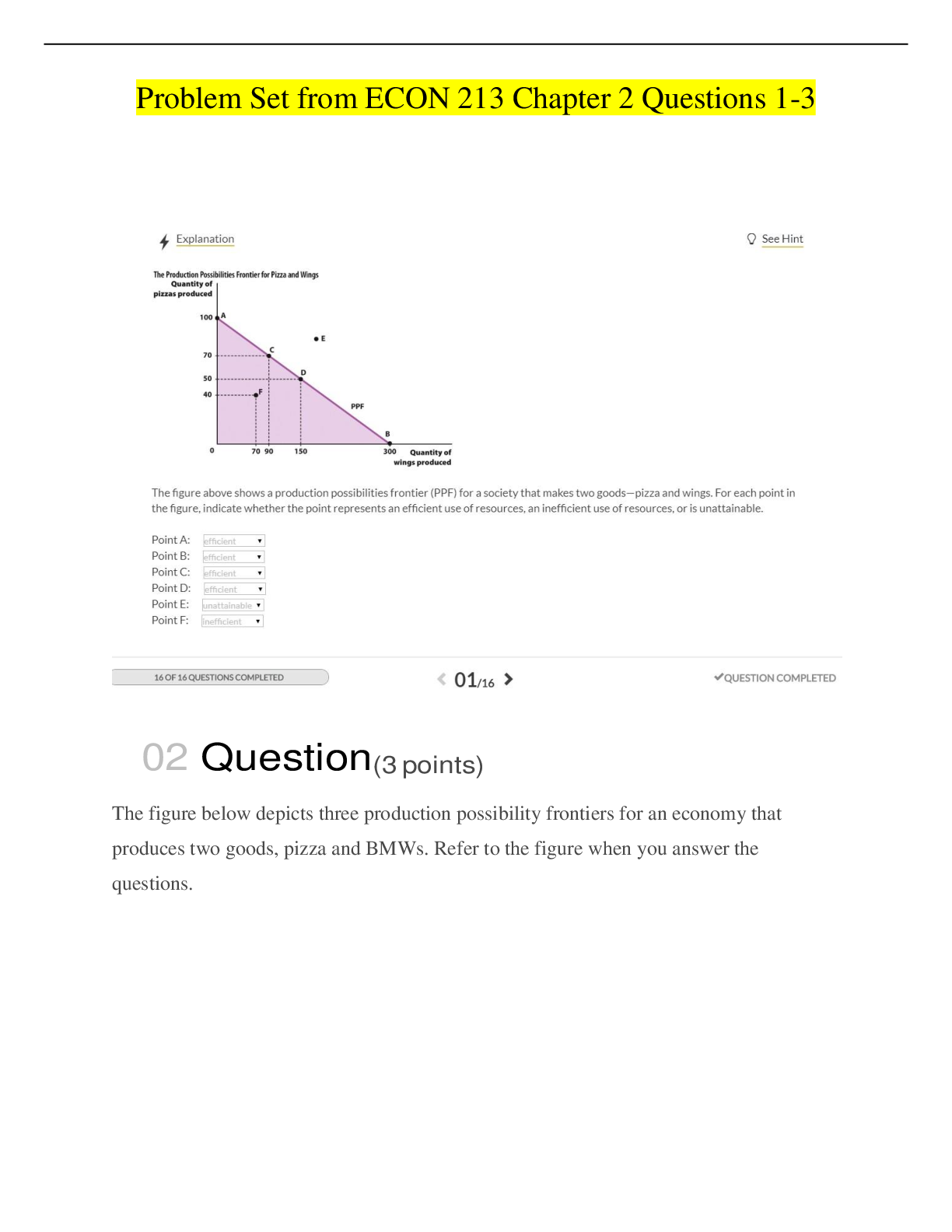
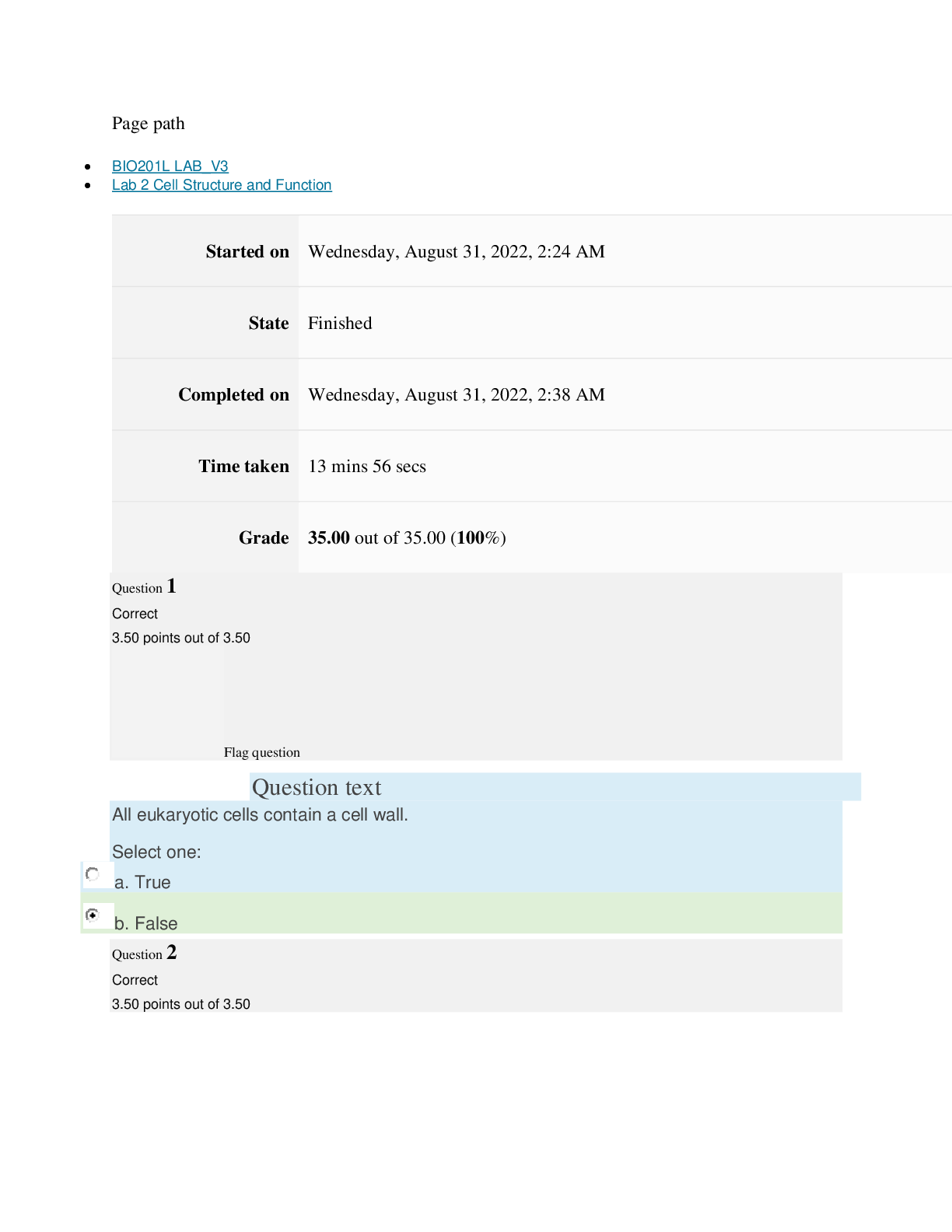

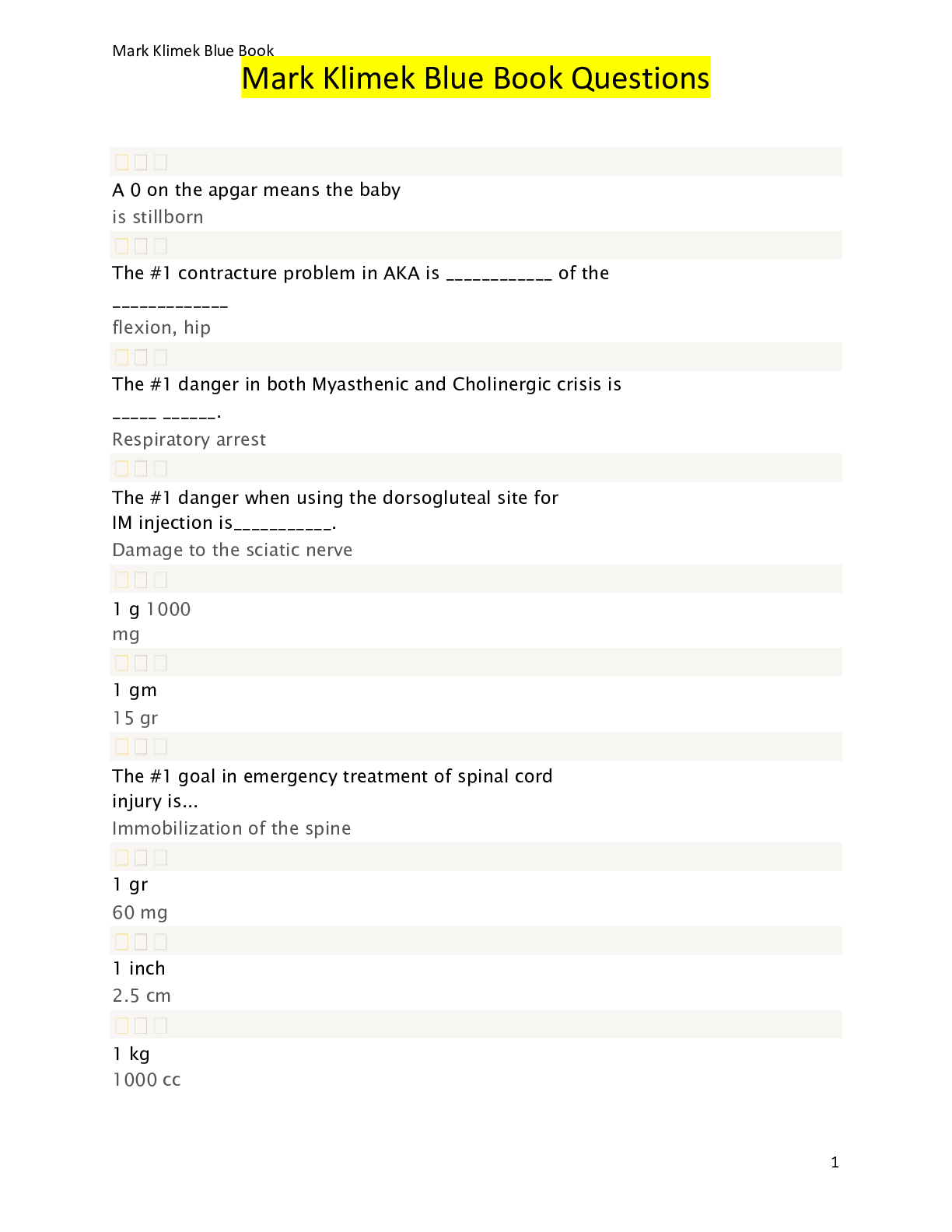

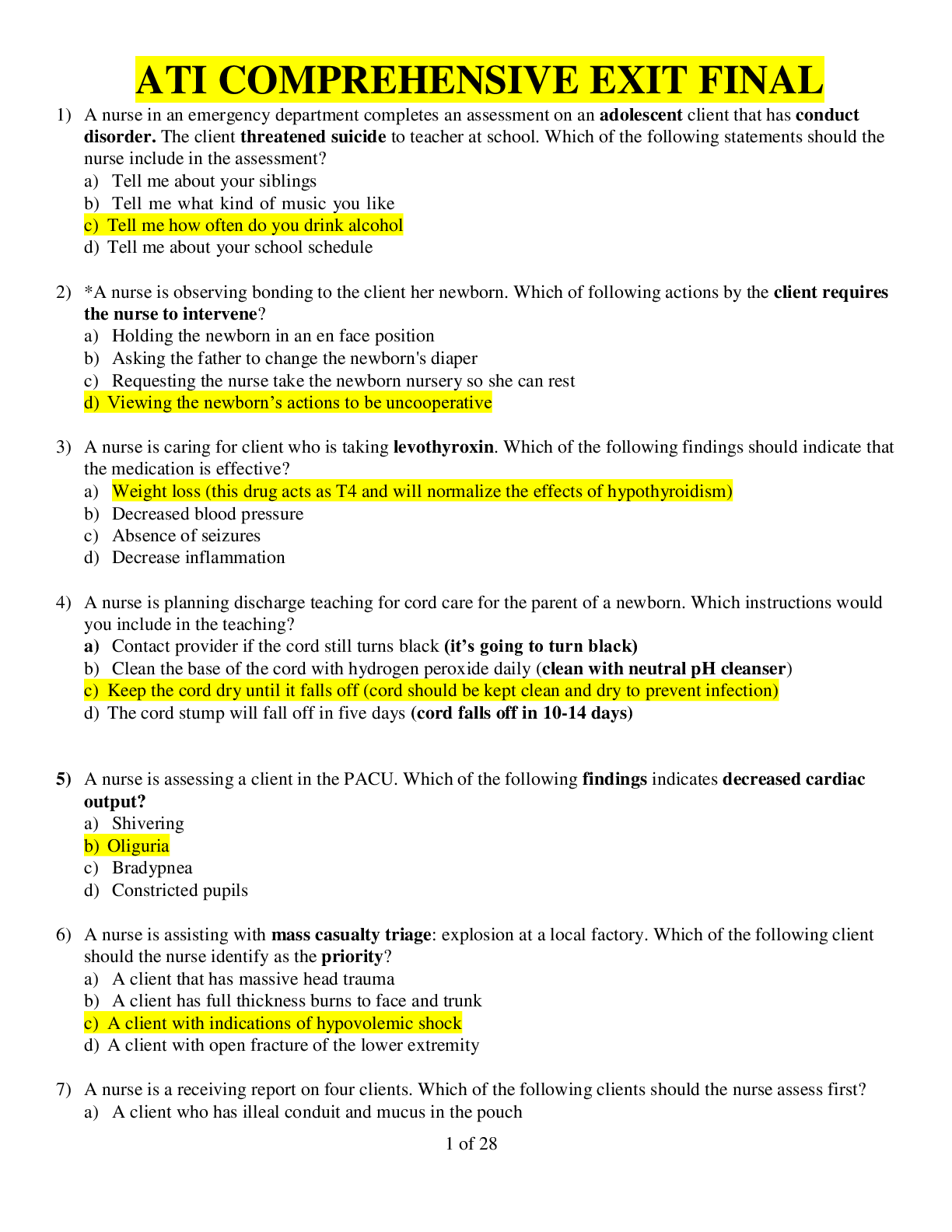

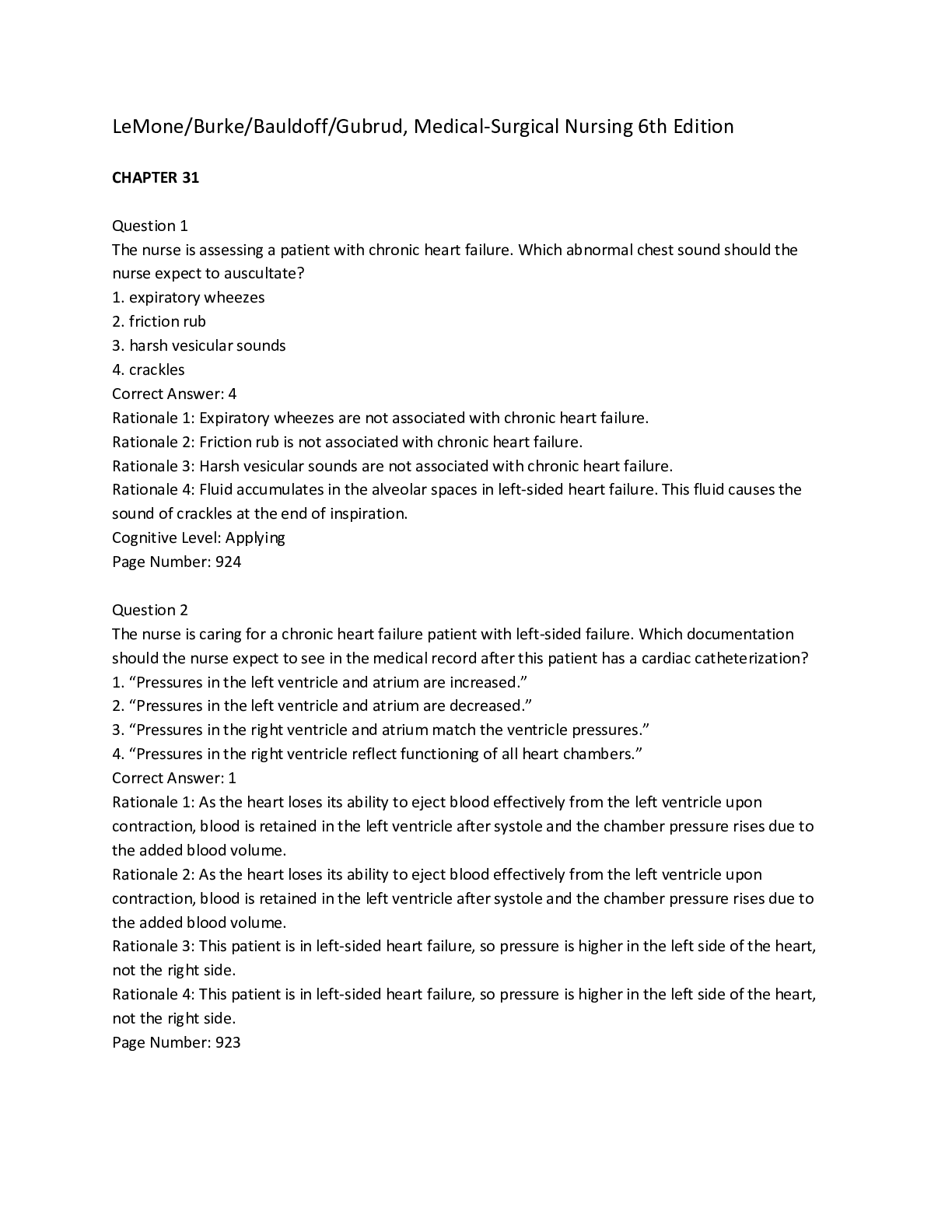
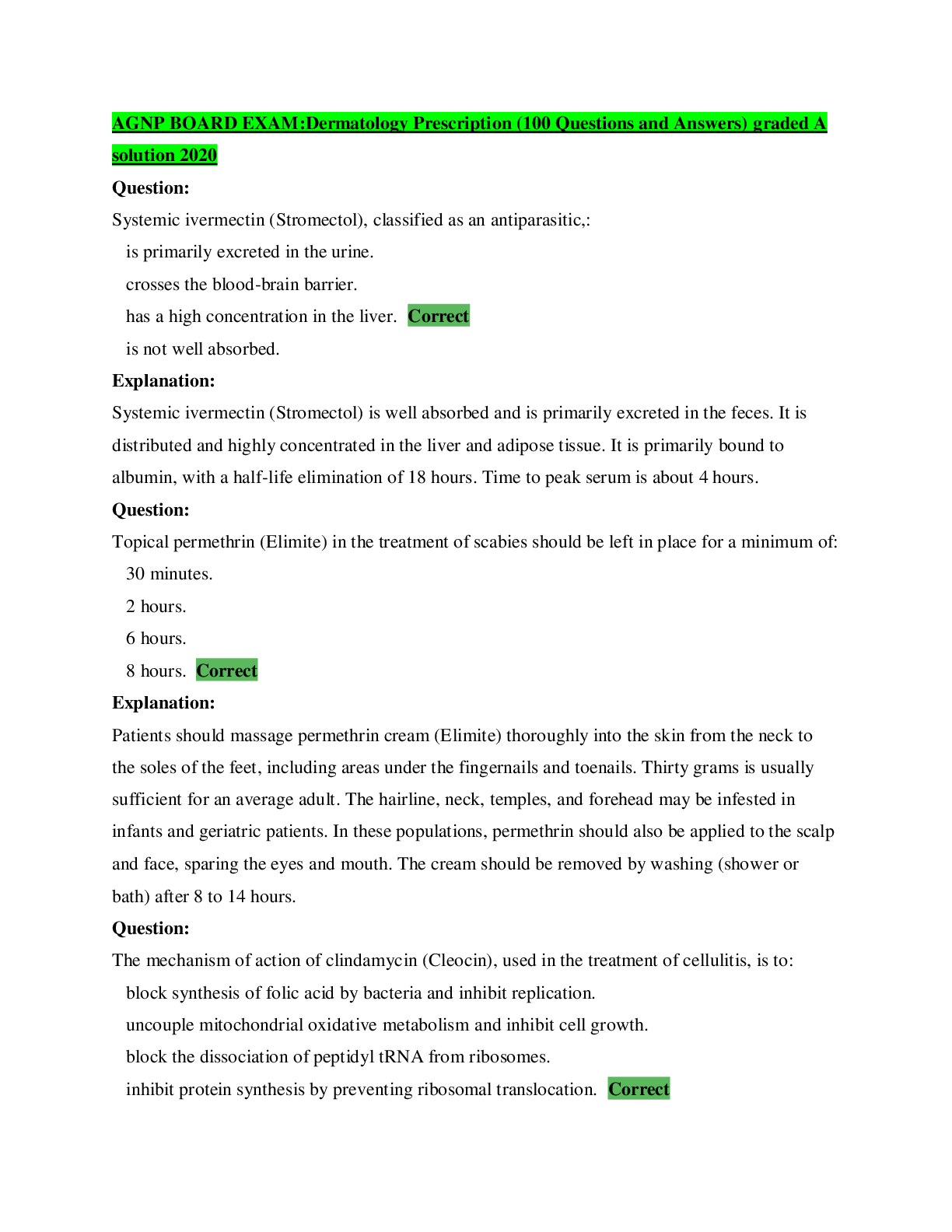
 Graded A.png)
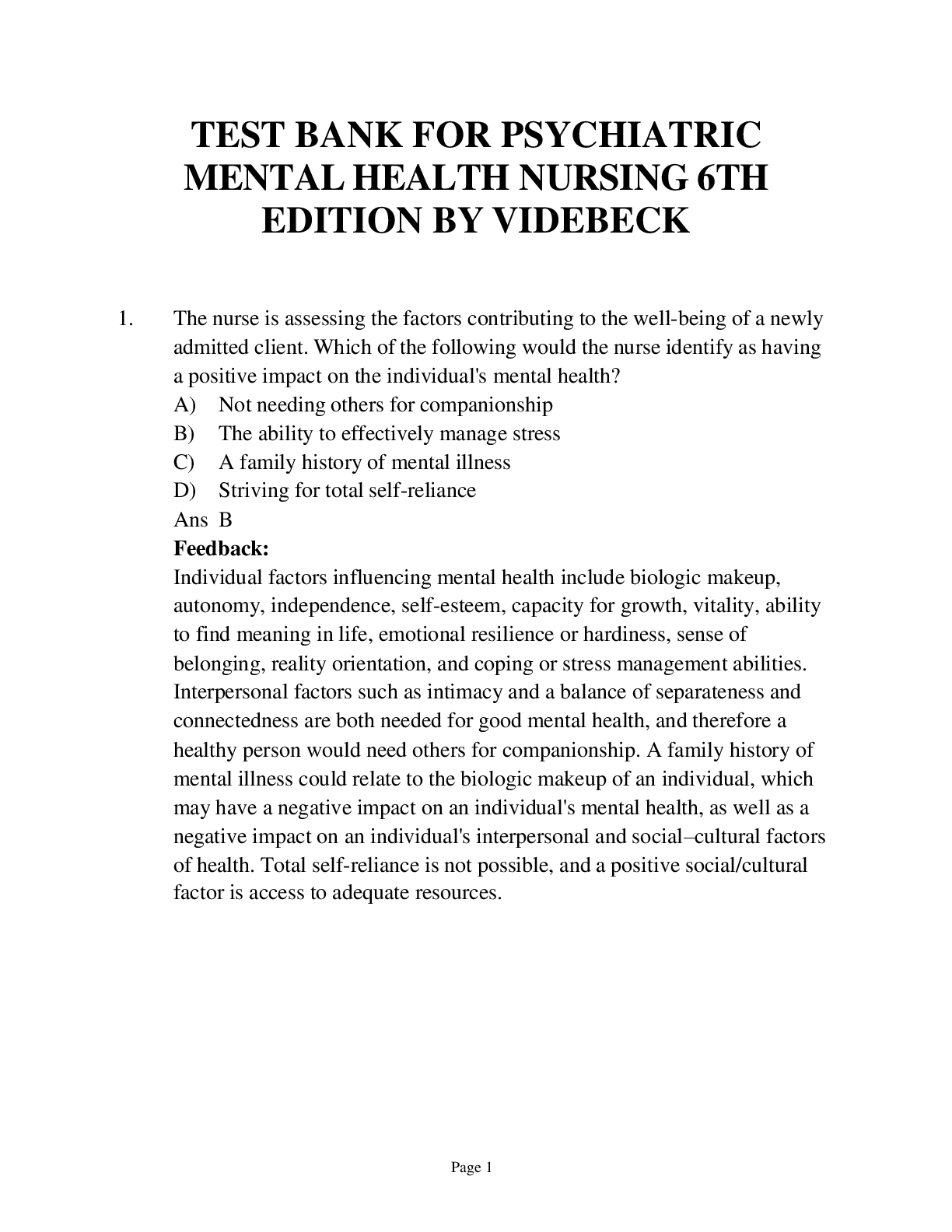
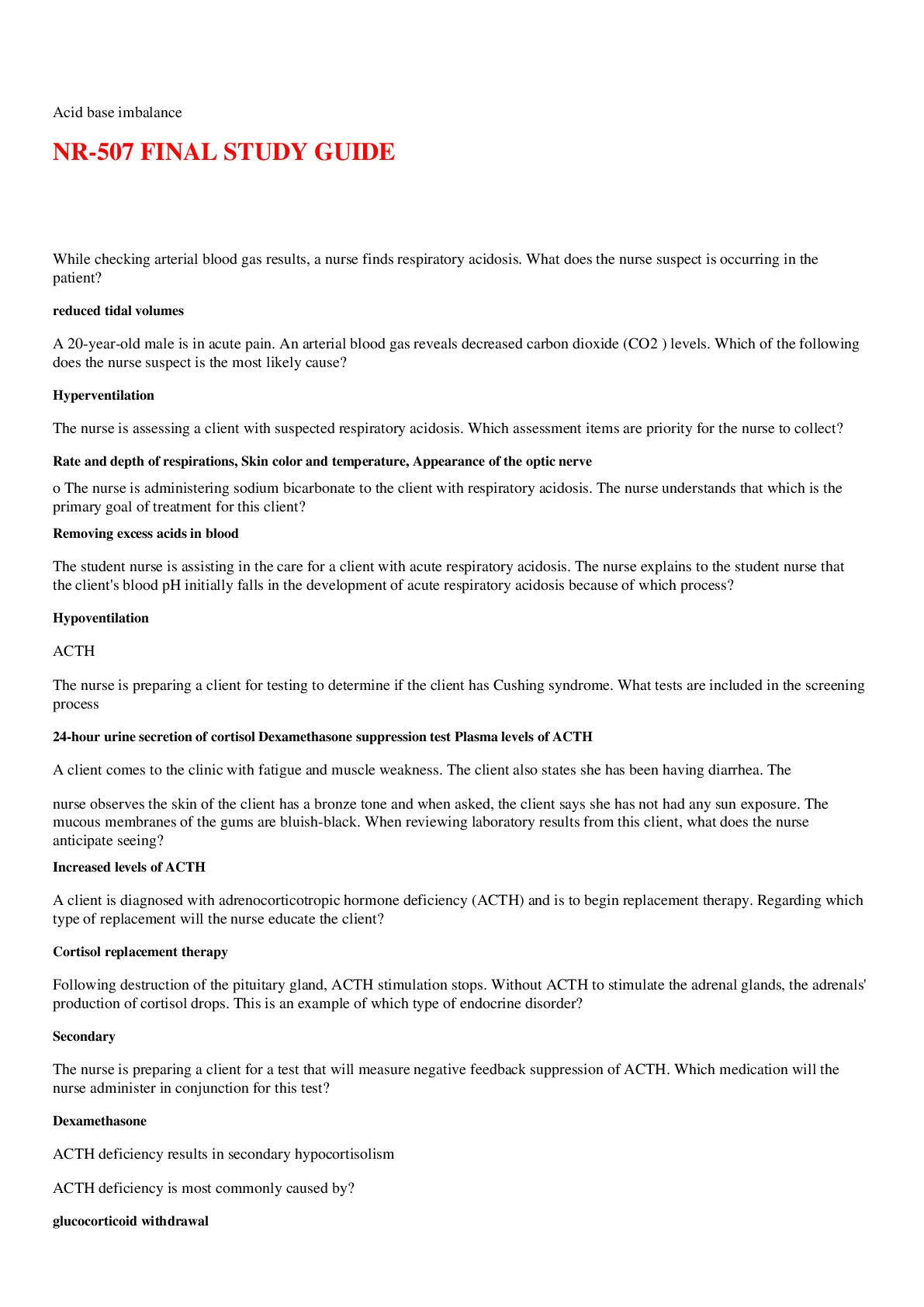

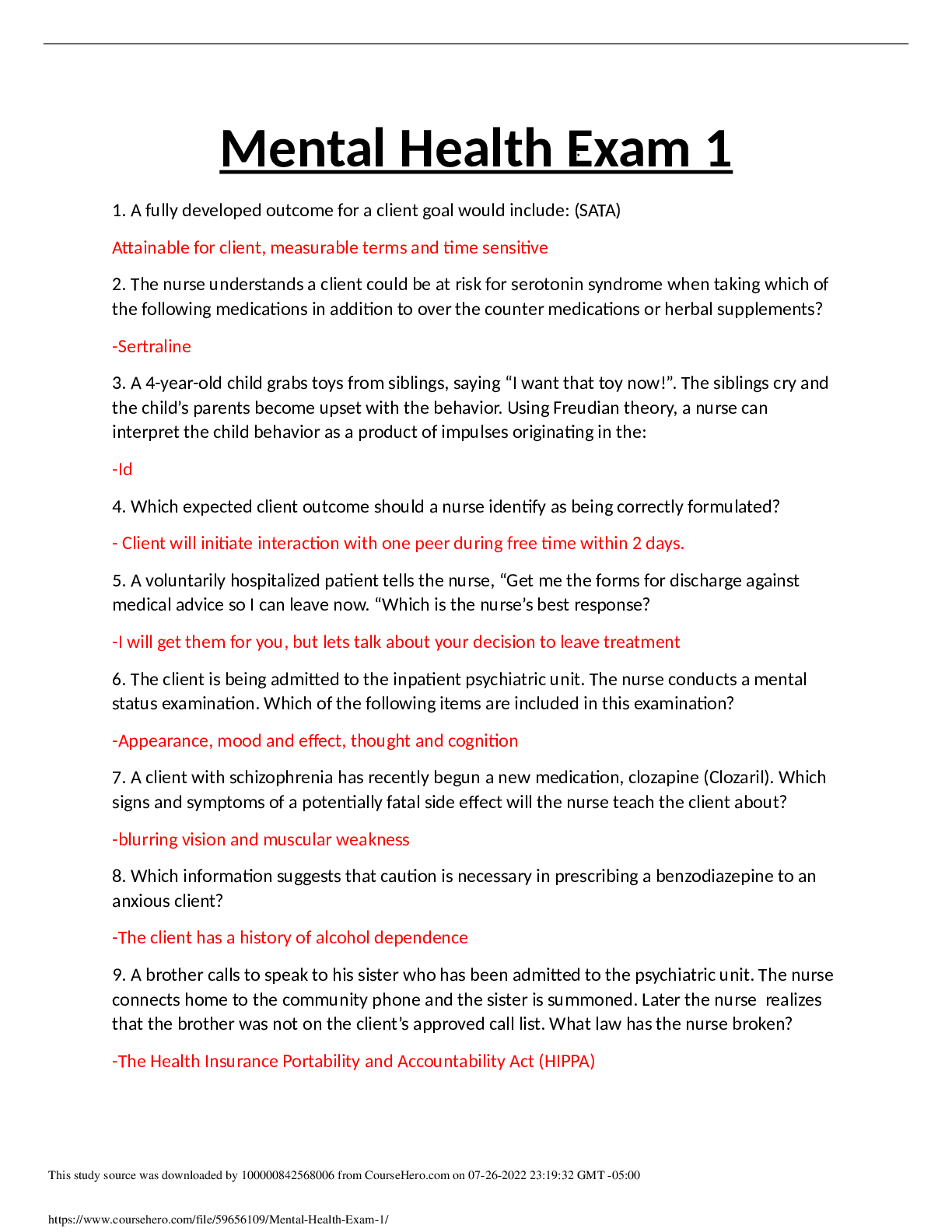

.png)
